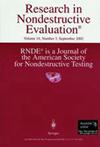Investigation of Magnetic Memory Signal of Propagation of Buried Crack under Applied Load
IF 1
4区 材料科学
Q3 MATERIALS SCIENCE, CHARACTERIZATION & TESTING
引用次数: 4
Abstract
ABSTRACT The timely detection of crack defects considerably helps prevent accidents caused by metal component failure. Further, magnetic memory detection technology has the advantage of detecting damage earlier than traditional nondestructive testing technology; however, the relationship between magnetic memory fields and welding cracks needs to be studied. Specimens with buried welding cracks were fabricated to study the magnetic memory field parameters of the propagation process of welding cracks. Variations in the magnetic memory signals of the crack at different loading stages were characterized. The magnetic memory detection method can effectively detect the buried welding crack defects. The magnetic field intensity gradient (dH/dx) demonstrated a regular change with the increase in the applied tensile load (P), which can be considered in two stages: In the first stage (P < 120 kN), dH/dx gradually decreased with P, and in the second stage (P > 120 kN), it rapidly increased before fracture.外加载荷作用下埋地裂纹扩展磁记忆信号研究
及时发现裂纹缺陷有助于防止金属构件失效造成的事故。磁记忆检测技术具有比传统无损检测技术更早发现损伤的优点;然而,磁记忆场与焊接裂纹之间的关系还有待进一步研究。通过制备埋地焊接裂纹试样,研究焊接裂纹扩展过程中的磁记忆场参数。分析了不同加载阶段裂纹磁记忆信号的变化规律。磁记忆检测法可以有效地检测埋焊裂纹缺陷。磁场强度梯度(dH/dx)随外加拉伸载荷(P)的增大呈规律性变化,可分为两个阶段:在第一阶段(P < 120 kN), dH/dx随载荷P的增大而逐渐减小,在第二阶段(P < 120 kN),在断裂前迅速增大。
本文章由计算机程序翻译,如有差异,请以英文原文为准。
求助全文
约1分钟内获得全文
求助全文
来源期刊

Research in Nondestructive Evaluation
工程技术-材料科学:表征与测试
CiteScore
2.30
自引率
0.00%
发文量
14
审稿时长
>12 weeks
期刊介绍:
Research in Nondestructive Evaluation® is the archival research journal of the American Society for Nondestructive Testing, Inc. RNDE® contains the results of original research in all areas of nondestructive evaluation (NDE). The journal covers experimental and theoretical investigations dealing with the scientific and engineering bases of NDE, its measurement and methodology, and a wide range of applications to materials and structures that relate to the entire life cycle, from manufacture to use and retirement.
Illustrative topics include advances in the underlying science of acoustic, thermal, electrical, magnetic, optical and ionizing radiation techniques and their applications to NDE problems. These problems include the nondestructive characterization of a wide variety of material properties and their degradation in service, nonintrusive sensors for monitoring manufacturing and materials processes, new techniques and combinations of techniques for detecting and characterizing hidden discontinuities and distributed damage in materials, standardization concepts and quantitative approaches for advanced NDE techniques, and long-term continuous monitoring of structures and assemblies. Of particular interest is research which elucidates how to evaluate the effects of imperfect material condition, as quantified by nondestructive measurement, on the functional performance.
 求助内容:
求助内容: 应助结果提醒方式:
应助结果提醒方式:


